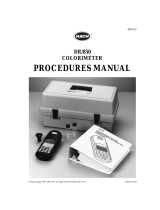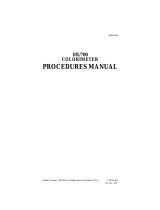Page is loading ...

59578-88
POCKET COLORIMETER
™
II
ANALYSIS SYSTEMS
INSTRUCTION MANUAL
Sulfate (SO
4
)
Silica (SiO
2
)
© Hach Company, 2006. All rights reserved. Printed in the U.S.A. te/dk 12/06 3ed

1—2
Important Note
This manual is intended for use with the following Pocket Colorimeter II
instruments:
The Pocket Colorimeter II instruments listed above are not interchangeable.
Silica, HR (SiO
2
) Cat. No. 59530-34
Sulfate (SO
4
) Cat. No. 59530-29

1—3
Table of Contents
Safety Precautions...............................................................................................1—7
Laboratory Safety...............................................................................................1—7
Use of Hazard Information................................................................................1—7
Precautionary Labels..........................................................................................1—8
Specifications.........................................................................................................1—9
Instrument Keys and Display...........................................................................1—11
Instrument Cap Cord.........................................................................................1—12
Silica, HR................................................................................................................1—15
Measuring Hints ...............................................................................................1—15
Sampling and Storage......................................................................................1—20
Accuracy Check................................................................................................1—21
Standard Calibration Adjust Method.............................................................1—22
Method Performance........................................................................................1—22
Interferences......................................................................................................1—22
Summary of Method........................................................................................1—24
Sulfate.....................................................................................................................1—27

1—4
Table of Contents, continued
Measuring Hints................................................................................................1—27
Sampling and Storage......................................................................................1—36
Accuracy Check.................................................................................................1—37
Standard Calibration Adjust Method..............................................................1—38
Method Performance........................................................................................1—38
Interferences......................................................................................................1—39
Summary of Method.........................................................................................1—39
Instrument Operation..........................................................................................2—3
Key Functions......................................................................................................2—3
Menu Selections..................................................................................................2—4
Switching Ranges................................................................................................2—4
Setting the Time..................................................................................................2—4
Recalling Stored Measurements........................................................................2—5
Battery Installation.............................................................................................2—6
Error Codes..............................................................................................................2—9
Error Messages ....................................................................................................2—9
Standard Calibration Adjust...........................................................................2—13

1—5
Table of Contents, continued
User-Entered Calibration................................................................................2—15
Overview............................................................................................................2—15
Calibration Procedure Using Prepared Standards........................................2—17
Entering a Predetermined Calibration Curve................................................2—20
Editing a User-entered or Factory Calibration Curve..................................2—22
Exiting the Calibration Routine......................................................................2—24
Deleting Calibration Points.............................................................................2—24
Retrieving the Factory Calibration.................................................................2—25
Maximum/Minimum Displayed Value...........................................................2—26
Certification..........................................................................................................2—29
How to Order........................................................................................................2—35
Repair Service......................................................................................................2—37
Warranty................................................................................................................2—38

1—6

1—7
Safety Precautions
Please read this entire manual before unpacking, setting up, or operating this
instrument. Pay particular attention to all danger and caution statements. Failure
to do so could result in serious injury to the operator or damage to the equipment.
To ensure the protection provided by this equipment is not impaired, do not use or
install this equipment in any manner other than that which is specified in
this manual.
Laboratory Safety
As part of good laboratory practice, please familiarize yourself with the reagents
used in these procedures. Read all product labels and the material safety data
sheets (MSDS) before using them. It is always good practice to wear safety glasses
when handling chemicals. Follow instructions carefully. Rinse thoroughly if
contact occurs. If you have questions about reagents or procedures, please contact
the manufacturer or distributor.
Use of Hazard Information
If multiple hazards exist, this manual will use the signal word (Danger, Caution,
Note) corresponding to the greatest hazard.

1—8
Safety Precautions, continued
DANGER
Indicates a potentially or imminently hazardous situation which, if not
avoided, could result in death or serious injury.
CAUTION
Indicates a potentially hazardous situation that may result in minor or
moderate injury.
NOTE
Information that requires special emphasis.
Precautionary Labels
Please pay particular attention to labels and tags attached to the instrument.
Personal injury or damage to the instrument could occur if not observed.
This symbol, if noted on the instrument, references the instruction manual
for operational and/or safety information.

1—9
Specifications
Lamp: Light emitting diode (LED)
Detector: Silicon photodiode
Photometric precision: ± 0.0015 Abs
Filter bandwidth: 15 nm
Wavelength: 450 nm
Absorbance range: 0–2.5 Abs
Dimensions: 3.2 x 6.1 x 15.2 cm (1.25 x 2.4 x 6 inches)
Weight: 0.2 kg (0.43 lb)
Sample cells: 25 mm (10 mL), AccuVac
®
Ampuls
Operating conditions: 0 to 50 °C; 0 to 90% relative humidity (noncondensing)
Power supply: Four AAA alkaline batteries; approximate life is 2000 tests*
* Backlight usage will decrease battery life.

1—10
OPERATION
DANGER
Handling chemical samples, standards, and reagents can be dangerous. Review the necessary
Material Safety Data Sheets and become familiar with all safety procedures before handling
any chemicals.
DANGER
La manipulation des échantillons chimiques, étalons et réactifs peut être dangereuse. Lire les Fiches
de Données de Sécurité des Produits (FDSP) et se familiariser avec toutes les procédures de sécurité
avant de manipuler tous les produits chimiques.
PELIGRO
La manipulación de muestras químicas, estándares y reactivos puede ser peligrosa. Revise las fichas
de seguridad de materiales y familiarícese con los procedimientos de seguridad antes de manipular
productos químicos.
GEFAHR
Das Arbeiten mit chemischen Proben, Standards und Reagenzien ist mit Gefahren verbunden. Es
wird dem Benutzer dieser Produkte empfohlen, sich vor der Arbeit mit sicheren Verfahrensweisen
und dem richtigen Gebrauch der Chemikalien vertraut zu machen und alle entsprechenden
Materialsicherheitsdatenblätter aufmerksam zu lesen.
PERIGO
A manipulação de amostras, padrões e reagentes químicos pode ser perigosa. Reveja a folha dos
dados de segurança do material e familiarize-se com todos os procedimentos de segurança antes
de manipular quaisquer produtos químicos.
PERICOLO
La manipolazione di campioni, standard e reattivi chimici può essere pericolosa. La preghiamo di
prendere conoscenza delle Schede Techniche necessarie legate alla Sicurezza dei Materiali e di
abituarsi con tutte le procedure di sicurezza prima di manipolare ogni prodotto chimico.

1—11
Instrument Keys and Display
Item Description
1 POWER/BACKLIGHT Key
2
ZERO/SCROLL Key
3
MENU Key
4 Numeric Display
5 Range Indicator
6 Range Indicator
7 Menu Indicator
8 Calibration Adjusted Indicator
9 Battery Low Indicator
10
READ/ENTER Key

1—12
Instrument Cap Cord
The instrument cap for the Pocket Colorimeter™ II doubles as a light shield.
Accurate measurements cannot be obtained unless the sample or blank is covered
with the cap. Use the instrument cap cord to secure the cap to the body of the
colorimeter and prevent loss of the cap. See Figure 1 on page 1—13.
1. Loop the instrument cap cord through the ring on the cap.
2. Remove the battery compartment cover. Press the knotted end of the cord into
the hole indicated by the arrow.
3. Slide the cord into the slot on the battery compartment cover. Snap the cover
into place.

1—13
Instrument Cap Cord, continued
Figure 1 Attaching the Instrument Cap Cord

1—14

1—15
Silica, HR (1 to 100 mg/L SiO
2
)
Method 8185
For water and seawater
Silicomolybdate Method
Measuring Hints
• If samples cannot be analyzed immediately, see Sampling and Storage on
page 1—20.
• Sample temperature should be 15–25 °C (59–77 °F) for accurate results.
• Wipe sample cells with a soft, dry cloth before placing in the instrument.
• After adding reagent, a yellow color will develop if silica or phosphorus is
present.
Note:
The Pocket Colorimeter II is designed to measure solutions contained in sample cells.
DO NOT
dip the meter in the sample or pour the sample directly into the cell holder.

1—16
Silica, HR, continued
1.Press the POWER key to
turn the meter on.
The arrow should indicate
mg/L SiO
2
.
Note:
See page 2—4 for
information on selecting the
correct range channel.
2.Fill two 10-mL sample
cells with 10 mL of sample.
Cap one of the cells (the
blank) and set it aside.
3.Add the contents of one
Molybdate Reagent Powder
Pillow to the remaining cell.
Cap the cell and shake
gently to mix.

1—17
Silica, HR, continued
4.Add the contents of one
Silica, HR Acid Reagent
Powder Pillow. Cap the cell
and shake gently to mix.
5.Wait 10 minutes. 6.Uncap the cell. Add the
contents of one Citric Acid
Reagent Powder Pillow. Cap
and shake gently to mix.
This is the prepared sample.
Note:
Any color due to
phosphorus is removed in
this step.
HRS MIN SECHRS MIN SEC

1—18
Silica, HR, continued
7.Begin timing a
two-minute reaction period
and proceed with step 8.
Note:
Wipe fingerprints or
liquid off both cells.
8.Place the blank in the
cell holder.
9.Cover the blank with the
instrument cap.
HRS MIN SECHRS MIN SEC

1—19
Silica, HR, continued
10. Press ZERO/SCROLL.
The display will show
“- - - -” then “0”.
Remove the blank from the
cell holder.
11. Immediately after the
two-minute reaction period,
place the prepared sample in
the cell holder.
12.Cover the sample cell
with the instrument cap.

1—20
Silica, HR, continued
Sampling and Storage
Collect samples in clean plastic or glass bottles. Analyze samples as soon as
possible after collection. If necessary, store samples up to 7 days at 4 °C (39 °F) or
below. Warm samples to room temperature before analysis.
13.Press READ/ENTER.
The display will show
“- - - -”, followed by results
in mg/L silica (SiO
2
).
/










